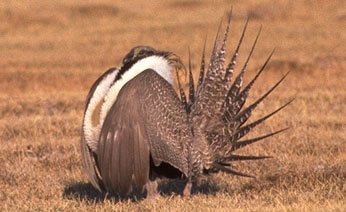Life History
 Photo by Dr. L. G. Ingles, California Academy of Sciences.
Photo by Dr. L. G. Ingles, California Academy of Sciences.
The greater sage-grouse, or "sage hen" as it is commonly called, is the largest native grouse in North America. Among the fowl-like birds, only the turkey is larger than the sage grouse. The sage grouse is a permanent resident in northeastern California, ranging from the Oregon border along the east side of the Cascade Range and Sierra Nevada to northern Inyo County. Lassen and Mono counties have the most stable populations. The greatest abundance of sage-grouse are found in a combination of sagebrush, perennial grassland or wet meadow, and water. Bitterbrush and alkali desert scrub are also commonly present. Males from several square miles gather at traditional strutting areas (leks) in late winter and early spring. These leks are located on patches of bare ground surrounded by sagebrush stands of moderate canopy. Some population movements may occur in winter.
Open areas within sagebrush communities are needed for courtship displays. Fairly open stands of sagebrush are needed for nesting. The nest is a shallow scrape with a thin lining of plant material; often placed under sagebrush. Breeding occurs from mid-February to late August. The peak strutting period is March-April. Nesting and brooding period is May-July. All males in a local area gather to display (lek) during the early breeding period. A few dominant males do most of the mating. Clutch size is 5-13; averaging 7-8. The incubation period is 25 days. The female cares for the young. Young sage grouse first fly at 7-14 days.
Adults feed primarily on sagebrush and leafage of green grass, forbs, clover, sunflower and supplement their diet with insects, particularly grasshoppers.
Hunting
Sage-grouse when alarmed will emit a sharp cackle, "kek-kek-kek". Sage-grouse rise from the ground slowly under labored wing beats, however, they are able to gain speed quickly for such a large bird.
Young sage-grouse are excellent eating and are considered a prized game bird by those who hunt them. Older birds may be tough and often have a strong sage flavor as a result of their diet. This flavor can often be prevented by cleaning the bird quickly after they are shot.